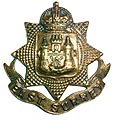Badges of
The East Surrey Regiment
3
 |
 |
 |
 |
| East Surrey Other Rank's Glengarry Badge 1881-02 |
3rd Vol. Bn. Other Rank's Helmet Plate 1881-1902 |
1st Royal Surrey Rifle Volunteer Other Rank's Glengarry Badge 1881-1902 |
3rd & 4th Vol. Bn. Collar Badge 1902-08 |
The 2nd Volunteer Battalion used a cap badge similar to that of the regulars, a star with the crowned arms of Guildford upon a shield, upon a scroll inscribed "East Surrey", with a Victorian "imperial" crown and a small scroll at the base of the shield bearing "2nd V. B.", all white metal. After the award of a battle honour, a scroll inscribed "South Africa 1900-01" was added to the base of the title-scroll, and the crown became a proper "Imperial" pattern. The officers' helmet plate was like that of the regulars, but with an additional lower scroll bearing "2nd Volunteer Battalion". The other ranks' plate-centre was like that of the regulars but was inscribed "East Surrey/2nd Volr. Battn.", and with a crown above the plate-centre served as a glengarry badge. Initially these badges were blackened (the officers' examples with polished silver highlights), but they later adopted the uniform of the regular battalions, with white metal insignia. The badges of the 4th Volunteer Battalion were similar, the cap badge having "4th V. B." on the additional scroll, and also with a second pattern with the same honour-scroll added. The helmet plate centres were the same, but for the inscription "East Surrey/4th volr. Battn". A variation on the usually white metal material of Volunteer battalion badges was found on the 1902-08 (Imperial crown) version of the officer's helmet plate of the 4th Volunteer Battalion, which although of silver had a gilt castle and title-scrolls.
The 3rd Volunteer Battalion retained the rifle corps style of its badges. Its helmet plate consisted of a crowned Maltese cross, with small lions in the spaces between the arms, with the star and Guildford shield in the centre of the cross, within a circlet inscribed "East Surrey/3rd volr. Battn." At the outer edges of the arms of the cross were the names of the component areas which contributed to the battalion: on the upper arm "Kingston", on the left "Esher", right "Richmond" and bottom "Chertsey". The original plates had a Victorian crown, later the Imperial pattern, and were blackened. The glengarry badge was similar, but smaller, without the lettering upon the arms, without the lions, and with balls" on the points of the arms of the cross.
In 1908 the 2nd and 3rd Volunteer Battalions became the regiment's 5th and 6th Territorial Battalions; the 1st Surrey Rifles and the 4th Volunteer Battalions became the 21st and 23rd Battalions of the London Regiment respectively. The 6th Battalion continued to wear a badge of Maltese cross design, with "South Africa" on the upper arm and "1900-02" on the lower. In the centre was a circlet inscribed The East Surrey Regt./6th Battalion" surrounding an eight‑pointed star bearing the arms of Guildford. Examples with voided and solid centres are recorded. The badge was blackened, with highlights in polished silver for officers and it was later replaced by the badge of the regular battalions, but blackened. An officer's badge is also recorded with the same design as their cross-belt plate: a crowned Maltese cross, with the centre as described before, with "South Africa/1900-02" on the upper arm only, blackened with silver highlights. The battalion's band pouch badge consisted of the design of the regular battalion's badge, with the lower scroll inscribed "6th Bn. The East Surrey Regt."
Two of the battalions raised during world War I possessed distinctive insignia. The 12th Battalion, raised in Bermondsey in 1915, obtained permission to use collar badges of the arms of Bermondsey (a shield with lion at the top and motto-scroll below, in pairs), although the commanding officer insisted that the regular cap badge should be worn. A distinctive cap badge was worn by the 13th Battalion, however, formed in Wandsworth in 1915.
 |
 |
 |
 |
| 13th Wandsworth Bn. Other Rank's Cap Badge 1914-18 |
12th Bermondsey Bn Collar Badge 1914-18 |
Other Rank's 1916 Economy Issue Cap Badge |
1942 Other Rank's Plastic Economy Issue |
Designed by the Secretary to the Mayor of Wandsworth, Mr T. C. Willett, it was like the badge of the regular battalions but bearing a shield of the arms of Wandsworth, over a scroll inscribed "We Serve" in brass with white metal star, bronze for officers.
For the remainder of the regiment, the ordinary cap badge was produced in an "economy" issue, all in brass, during World War I, and during World War II another in light bronze plastic. From 1951 a smaller pattern badge was produced for wear in the beret, and from 1954 both sizes were produced with the St. Edward's crown, the cap badge also in silver and gold anodised aluminium.
 |
 |
 |
 |
| 21st Bn. The London Regt. (First Surrey Rifles) Other Rank's Cap Badge 1908-38 |
21st Bn. The London Regt. (First Surrey Rifles) Other Rank's Collar Badge 1908-38 |
23rd Bn. The London Regt. Officers SD Cap Badge 1908-52 |
23rd Bn. The London Regt. Officers Cap Badge 1952 |
In 1959 the regiment was amalgamated with the Queen's Royal Regiment (West Surrey) to produce the Queen's Royal Surrey Regiment, of which the 4th Battalion was formed by the amalgamation of the East Surrey Regiment's Territorial element (6th Battalion) and the 23rd London Regiment (the latter, having originally been part of the East Surrey Regiment, was thus re-united, albeit in a new formation).
« Previous ![]() Back to List
Back to List ![]() Next »
Next »
